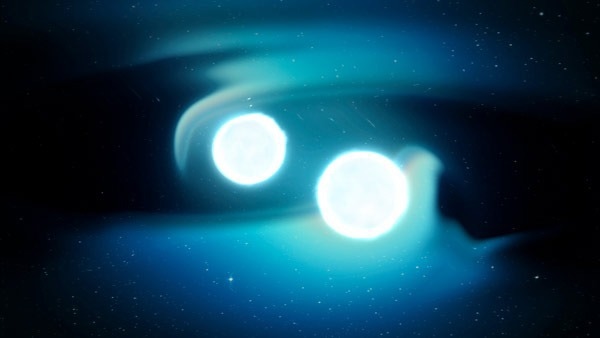According to calculations performed by RIKEN researchers, they forecast that telltale signatures in gravitational-wave signals from merging neutron stars might disclose what happens to matter at the extreme pressures produced by mergers.

Gravitational waves generated by mergers between two neutron stars could reveal the creation of free quarks through such mergers. Image Credit: Laguna Design/Science Photo Library
If you increase the pressure in a container, a point where the atoms crash is reached and develops an ultra-dense soup of protons and neutrons. The only place in the Universe where this takes place is neutron stars, the collapsed remnants of burned-out stars, and it generates breath-taking densities—one teaspoon of such material weighs many hundred billion kilograms.
However, the study questions what would happen if you continued to increase the pressure further. This question is hard to answer, even for astrophysicists.
At the center of neutron stars, the density is nearly three to five times higher compared to that of an atomic nucleus; it is the highest density known to be achievable before the formation of a black hole. No one is aware of what happens to matter while being subjected to such extreme densities.
One theory hypothesizes that the ultra-dense soup of protons and neutrons will decompose into a soup of gluons and quarks. This is known to be the most basic building block of matter.
Some researchers believe that quark phases will appear in the center of neutron stars. But it’s a conjecture.
Shigehiro Nagataki, Astrophysical Big Bang Laboratory, RIKEN
A promising method to find the existence of an unusual form of matter is by witnessing the mergers of two neutron stars with the help of gravitational-wave detectors.
If it does prevail, there are two chances for how neutrons and protons would disintegrate into their constituent quarks at the time of mergers. They could undergo a sharp transition, as liquid water turns into vapor at its boiling point at normal pressures, or there can be a fuzzy shift, similar to how water turns to vapor at pressures more than its critical point.
Nagataki and co-workers have excited mergers between two neutron stars and evaluated the gravitational waves that would be generated by them to explore the second likelihood.
Normally, the frequency of the gravitational waves from neutron-star mergers relies on how fast the neutron star rotates. Larger neutron stars generally rotate in a slower motion.
The team discovered that it must be possible to probe if the quark phase exists in a neutron star by examining the frequency of its gravitational waves. If it does subsist, the gravitational waves can also disclose how the quark phase takes place.
While the gravitational-wave detectors available at present fail to detect this, the next generation of detectors, which will be coming online in the next 10 years or so, must be able to.
It’s amazing to think we should be able to detect the type of transition by detecting gravitational waves.
Shigehiro Nagataki, Astrophysical Big Bang Laboratory, RIKEN
Journal Reference:
Huang, Y-J., et al. (2022) Merger and Postmerger of Binary Neutron Stars with a Quark-Hadron Crossover Equation of State. Physical Review Letters. doi.org/10.1103/PhysRevLett.129.181101.